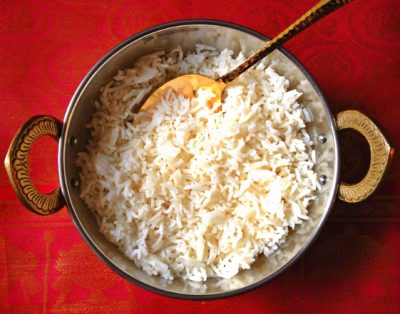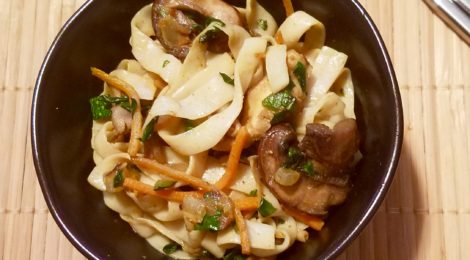
Curried Shirataki Noodles
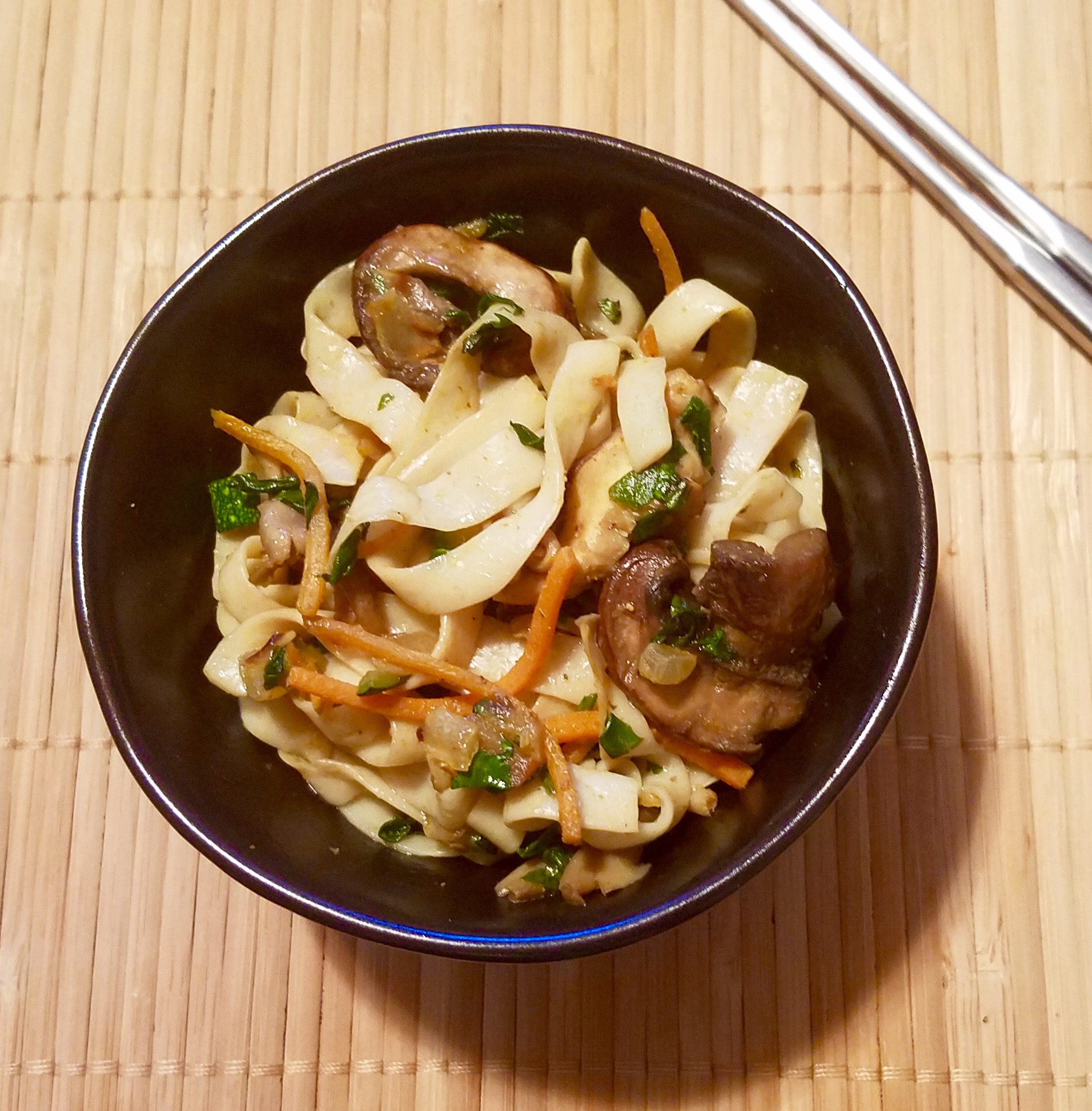
Curried Shirataki Noodles with Shredded Carrots, Wild Mushrooms, Green Zucchini, and Baby Spinach
I was flipping channels the other day and caught a headline that said one way to “lose a dress size” is to switch from regular pasta to Japanese shirataki noodles instead. Really? Apparently doing this twice a week = losing more than 10 pounds a year. This made me lean forward on the sofa. Lose weight by eating noodles? If an average serving of fettuccini noodles is 200 calories and 40g of carbohydrates for instance, the same-sized serving of shirataki noodles is 10 calories and 3g of carbohydrates. They have 0g of sugar and 15g of sodium. Wow. That certainly got my attention.
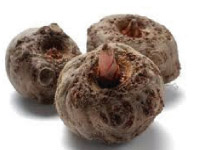
Japanese konjac yam (Photo source: Indochina Organic Farming Development Center)
So what are these noodles, exactly? Shirataki are traditional Japanese noodles made from a yam or sweet potato called the konjac yam. They look like a cross between a potato and a mushroom. While they have almost no nutritional value, whether you’re looking for low-carb, low-sugar, or gluten-free ingredients, shirataki noodles might do the trick for you. These noodles soak up the flavors of a hearty bolognese sauce or a spicy Thai curry and yet don’t leave you feeling weighed down and bloated after inhaling a bowl of them. It’s not a direct substitute for pasta of course, so keep that in mind. The texture is rubbery and tasteless, and lacks the addictive toothsome quality of al dente pasta or thin rice vermicelli. Still, add a little parmesan cheese and shirataki noodles could be a great alternative to pasta or rice once in a while. Who knew? I certainly didn’t until now.
I just had to try it. I bought a package, which are usually in the refrigerated section where you might find tofu in your supermarket. It is packed in water and keeps in the fridge for quite a while. In the product I used, the yam is combined with a small amount of tofu to help give it the fettuccini noodle shape, but the noodles don’t taste like tofu at all. I kept reminding myself that it wouldn’t have the texture of pasta, but to give it a shot and see if we liked it.
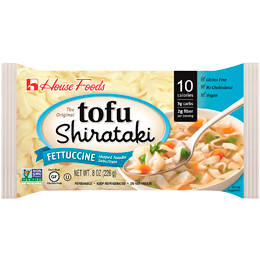
This is what I bought, which was the only type in my supermarket. This version combines the yam with a bit of tofu to help create a fettuccini shape. (Photo Credit: house-foods.com)
First, I had to figure out how to prepare the shirataki noodles properly. A bit of online research suggested I ignore the preparation instructions on the package. Instead, all I did was empty the noodles into a thin sieve and rinse them gently under cold water. Then, I let them sit in the sieve and drained any excess water over a small bowl. In the meantime, I laid out two clean kitchen towels on the counter. With my fingers, I carefully spread out the noodles on one towel and covered it with the other, gently patting them down. I left it alone and moved on to the curried vegetables.
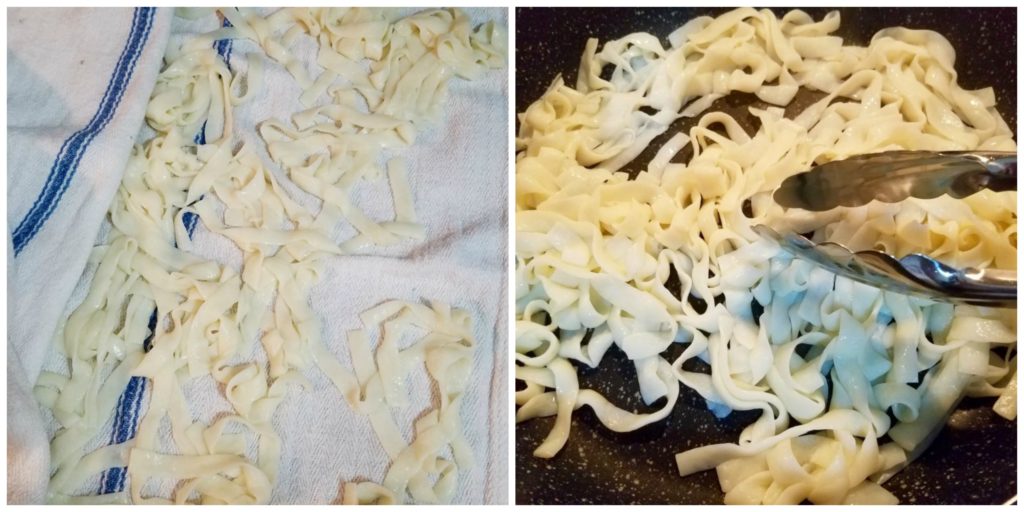
Left: Shirataki noodles require draining them completely and letting them dry out for a few minutes on a kitchen towel before sautéing them on their own in a non-stick skillet to remove any additional moisture. Right: The objective is to remove as much excess water as possible, which includes draining the noodles and then sautéing them in a non-stick skillet for a few minutes. This gives it more of the regular noodle texture we like.
You can use any vegetables you have on hand, in this case I love the classic stir-fry combination of shredded carrots, mushrooms, zucchini, and baby spinach, with bits of fresh cilantro to brighten the whole dish. In a wide, non-stick skillet I heated sesame oil and red chilli flakes together, and after sautéing onion, garlic and ginger, added one vegetable at a time, followed by curry powder and soya sauce. I set the skillet to the side, pulled out a smaller non-stick skillet, and on medium-high heat, I added the shirataki noodles and gently heated them by moving them around in the skillet often with a pair of tongs. This technique releases additional moisture from the noodles. After 5-10 minutes I combined the noodles with the stir-fried curried vegetables and dinner was done. You can serve these curried noodles with any kind of meat or fish, or simply on their own. I served them topped with Teriyaki and Pineapple Meatballs.
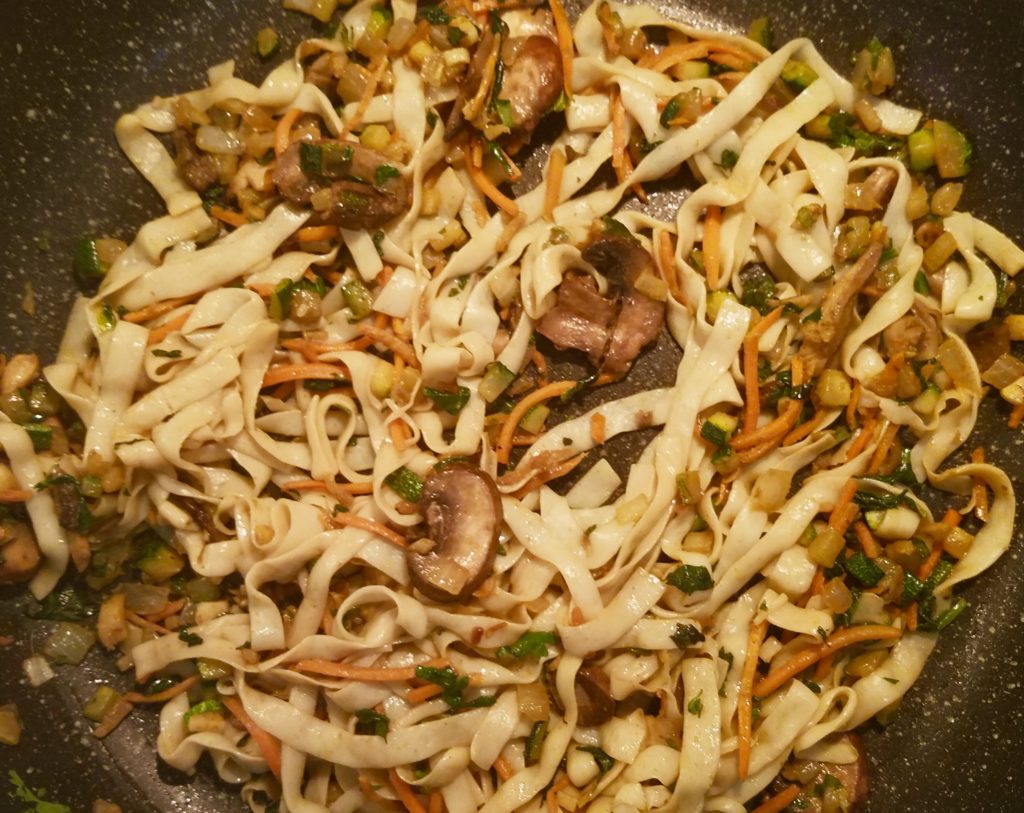
Since you don’t even have to boil the noodles, once they’re prepped, you add them to your skillet of curried stir-fry vegetables like this (or any other sauce, Italian or Asian or otherwise), and dinner is ready.
Verdict?
We liked it but the key was using the noodles in a dish that has robust flavors, as opposed to something more plain, hence I recommend making my Curried Shirataki Noodles. The spicy noodles dotted with tender zucchini, sweet carrot, and herby spinach and cilantro blended perfectly with the sweeter, saltier meatballs. The texture and bite of the noodles were certainly not like regular noodles, but taken together, a forkful of the noodles and the meatballs together made for a perfect bite because of the winning combination of flavors. Sean and I both noticed we felt quite light after dinner rather than feeling heavy, the way we normally would after eating a plate of noodles. Will we be making shirataki noodles a permanent fixture? I will definitely put it in my grocery cart next week.
Curried Shirataki Noodles
Serves 2
Ingredients
- 1 (8 oz) package of shirataki noodles, fettucini shaped
- 1 tablespoon sesame oil
- 1/4 teaspoon red chilli flakes
- 1/2 onion, finely chopped
- 1/2-inch piece of fresh ginger, peeled and finely chopped
- 2 garlic cloves, finely chopped
- 1/2 cup shredded carrots
- 1/4 green zucchini, finely diced
- 1/2 (5 oz) package of sliced mushrooms
- Handful of fresh baby spinach, finely chopped
- Handful of fresh cilantro, finely chopped
- 1/2 teaspoon sesame oil
- 1 tablespoon curry powder
- Soya sauce, to taste
Preparation
- Drain shirataki noodles in a fine sieve and gently rinse under very cold water. Next, set the sieve to drain over a small bowl. Lay a dry, clean kitchen towel flat on the counter. After 5-10 minutes, with your fingers, gently spread the noodles over the kitchen towel and cover with another kitchen towel, gently patting to dry. Leave it as is for the moment.
- Heat a large nonstick skillet over med-high heat; add sesame oil and red chilli flakes.
- Add onion, garlic, ginger, and shredded carrots. Sauté for a couple of minutes until onions are glassy. Add zucchini, mushrooms, and baby spinach. Sauté until the vegetables are al dente. Add sesame oil, curry powder, and soya sauce, mixing well to combine. Set skillet aside.
- Heat another medium-sized nonstick skillet over medium-high and carefully add the drained shirataki noodles from the kitchen towel. Using tongs, gently push the noodles occasionally; this removes additional moisture from the shirataki. Do this for 5-8 minutes.
- Add the noodles to the skillet with the veggies and stir well to combine. You can put the heat on and stir-fry for 1 minute or until thoroughly heated.
